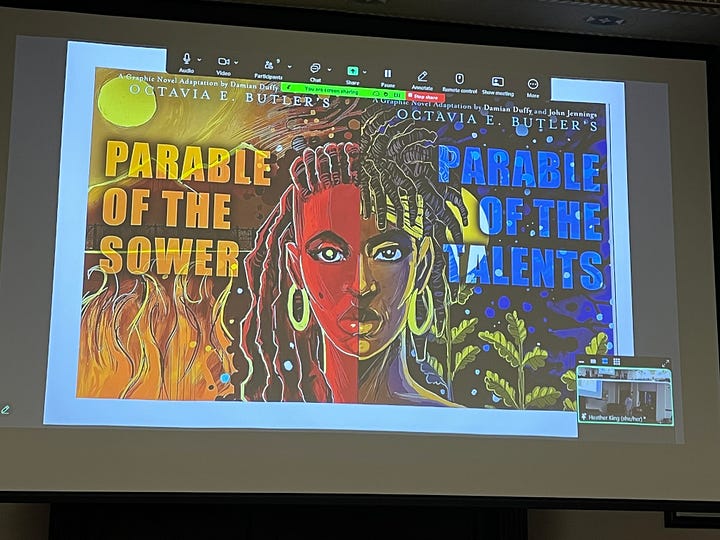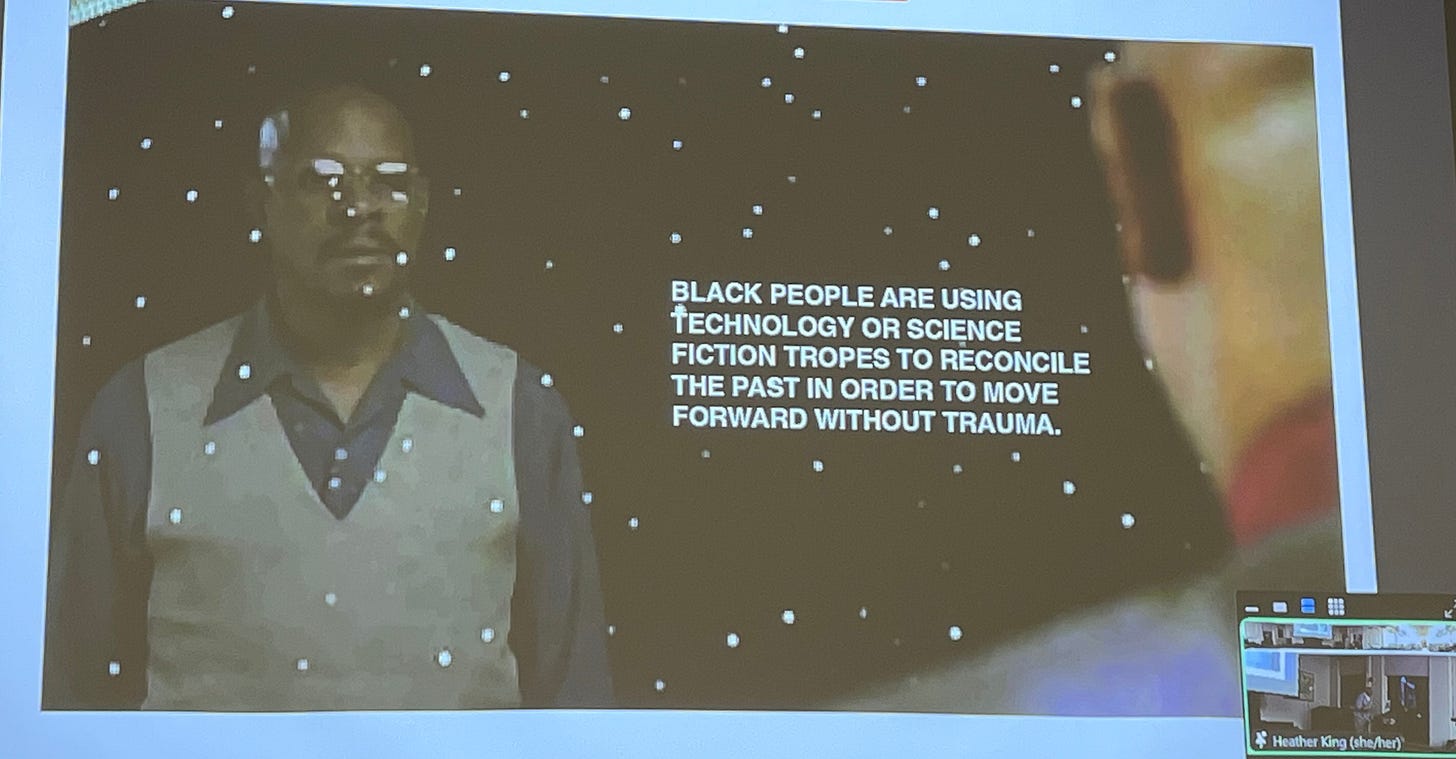Parable of the Sower, graphic novel edition
How Redlands continue to discuss Octavia E. Butler’s work and her influence culturally
This past week I’ve pondered why Butler’s work so speaks to me. And I think in a twisted way her profound prophetic dystopian writing not only feeds my natural tendency for anxiety but also quells it. If that is even possible.
Let me explain by inviting you to the past week’s events.
At the One City One Book discussion of the graphic novel version of “Parable of the Sower” eight people showed up. A perfect size for a book club.
English professor at University of Redlands, Heather King, explained Octavia E. Butler’s background and reason for writing the book. We discussed how the ‘in your face’-images made the novel come to life. The dark and menacing colors throughout the book made the violence so sinister and visceral. Exemplified with the drawing of a bird on page 3 and 13.
We talked about the way, the illustrator made the protagonist, Lauren face the reader when she experienced hyper empathy. And King told us to notice that throughout the book hyper empathic episodes were colored in red. An alert. Would our world we live in today be better off if we had hyper empathy? And how would it differ from compassion and sympathy?
There were the pages dividing the book into separate years. The novel begins in 2024 with a star map and a premonition of the future plans, but in 2025 (page 22-23) the drawings of local plants made us think of a ‘call to action,’ to learn local survivability through edible plants. The years 2026 and 2027 (pages 80-81 and 120-121) are maps of Lauren’s home and Southern California respectively, that helped Lauren escape from a hellish situation.
The discussions from the graphic novel centered around the ways we could now visually imagine the world Butler had created.
And it became all the more clearer a few days later when illustrator, award-winning graphic designer, college professor at UC Riverside; John Jennings spoke about working on adapting Butler’s work into graphic novels.
The main point Jennings emphasized was the importance of representation. He teaches three different courses on Afro-futurism at UC Riverside and the one and half hour presentation felt like a crash course of that.
Even though Jennings did not learn about Octavia E. Butler’s work until 2007, he drew lines of how her work had been influential for the past forty years in literature, visual art and in movies and on TV.
In 2016 Jennings did an art installation in Buffalo, New York, in which his art discussed the intersection between blackness, stereotypes and sci-fi. John Jennings: Matterz of the Fact - This work propelled him into illustrating “Kindred” another popular sci-fi novel by Butler which won him and co-author Damian Duffy the Bram Stoker Award. For their “Parable of the Sower” graphic novel adaptation they won the Hugo Award.
Another initiative Jennings leads is MEGASCOPE. At Abrams Books he curates a line of graphic novels for and about people of color.
“A lot of Afro-futuristic work is about going back and understanding the past, re-mixing and thinking about it and representing it to future generations, so we can forget our past,” he said. This concept is called sankofarration. Other aspects include adding ancestral knowledge to future technology. Or the ways science fiction exists in music, like the imagination of blues music as a black secret technology. “It’s about understanding the world in extension of your humanity,” he said.
Jennings mentioned how so much of the Afro-futuristic work comes from the South.
“I often say, that the first Afro-futurist was the first slave that said, you know what this slave-thing is not a good thing. I think, I shall emancipate myself,” he said. “It was about thinking about the future. You have to think about the future.”
There are more black Science Fiction movies than one would think when you start to look into it. That is exactly what Jennings has studied.
Suggestions for watching Afro-futurism according to Jennings:
Sankofa (1993), Pumzi (2009, short), Eve (2016, short), Kin (2018), Fast Color (2018), Black Panther (2018), See You Yesterday (2019), God of Dreams (2022).
Especially go watch episode 7, season 1 of Lovecraft County called “I am” and episode 13, season 6 of Star Trek: Deep Space Nine called “Far Beyond the Stars.”
Because, “Speculative sci-fi narratives [can be used] to reimagine the past, interrogate the present and design a future where people of African-American Diaspora thrive in accordance to their own agency.”
A unique concept in Afro-futurism is also techgnosis, when there is a fusion of the spiritual with the technological.
So many of these concepts can be found in “The Parable of the Sower”: The Earthseed verses that is this whole new religion Lauren invents, because there is no future in the book without some kind of faith. And when Lauren and her misfit crew reach the hills of Humboldt county and create a new community called Acorn. Jennings called that the promised land.
“What Butler did, she was projecting, she was forecasting,” he said about the political climate, class struggles, water shortage and serious climate change catastrophes.
The book was done digitally on an IPad. Jennings had a son while drawing, “We had a baby and a book baby at the same time,” he said. The colors are inspired by the nature here in Southern California, “The mountains, the grounds and the grass,” he said using an app called Capture to find the exact colors from nature.
The graphic book adaptation of Kindred is set in the tones of what bruises look like. And the blue-teal color that is often used in the South to warn off spirits, is used for the main character, Dana. “It’s almost like Dana is haunting her own existence or her own past,” he explained. “There is color theory everywhere in that book,” he said.
“One of the most amazing things about comics is that every aspect of a comic book page is a vehicle for storytelling: the color choice, the word, the font, the shape of the panel. It’s very different from every other medium,” he said.


For Damian Duffy, who wrote the adaptation with Jennings, read the novel 13-14 times. The adaptation collaboration they did was not only in conversations with each other and Butler’s work but also editors, copy editors and production designers etc. “There is no ego, when you do an adaptation,” he said. “It’s really about what is the main idea of the story.” One of the neat things that has happened afterwards is the approval by the estate of Octavia E. Butler, saying it’s close to the original.
“We want to celebrate Octavia Butler’s work,” he said ending the talk with my favorite quote from the evening:
“Octavia Butler has changed my life. Seriously. And hopefully some of those books we have done has changed other people’s lives.”

The second graphic book adaptation in the series, “Parable of the Talents,” will come out in April next year. Including a deck of tarot cards with the help of a Kickstarter campaign.
In conclusion..
Here I am learning why Octavia E. Butler’s work is life changing and resonates with so many of us, because she succinctly was able to study the past, live in the present and foretell the future. And living in an uncertain time of turmoil and division, what we can do is the exact same: Study the past, learn from it. Live in the present in a way that makes the future a bit better for all of us. And go watch some amazing Afro-futurism!
The program for this fall has concluded of the Parable Project 2024. Please, follow them on Instagram here: ‘parableproject24’
In the spring there will be a whole new series of community events, lectures, meditation, plant walk and more. I can’t wait.
Thank you for reading. If you enjoyed this piece, please like below and subscribe to my Substack: www.siwheede.substack.com






